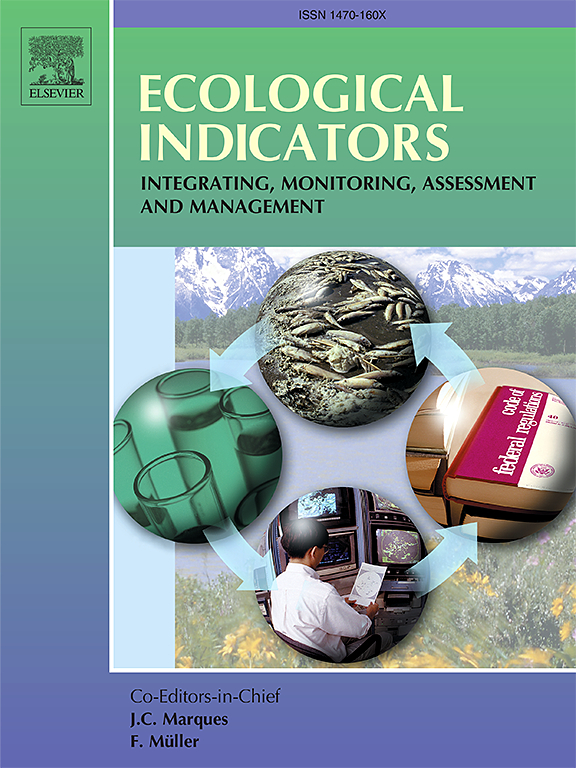环境污染物升高对红树林湿地碳储量的影响
IF 7
2区 环境科学与生态学
Q1 ENVIRONMENTAL SCIENCES
引用次数: 0
摘要
红树林湿地是全球碳循环中重要的蓝碳汇,贡献了沿海海洋环境中总有机碳的约10%。然而,快速的城市化和工业化排放了重金属、微塑料、有机污染物和石油泄漏等污染物,威胁着这些碳和生物多样性的功能。通过对全球38项研究结果的综合分析,发现重金属(Hg、Pb、Cd、Cr、Zn、Ni、As)通过改变红树林的微生物结构和影响植物的正常生长发育,使沉积物有机碳减少0.57 ~ 8.06%,CH4排放量增加90 ~ 150 μg−1 d−1。微塑料通过破坏光合作用和沉积物不稳定使碳储量减少1 - 12%,而有机污染物(即多溴二苯醚,多环芳烃)抑制植物生长和微生物碳加工。石油泄漏使光合作用能力降低了50%以上,加速了生物质的损失。这些影响共同破坏了红树林碳储存能力的稳定,而碳储存能力是减缓气候变化的关键功能。我们提出了基于证据的缓解策略,包括陆地-海洋排放路径的污染监管,使用有弹性的物种(如Avicennia marina)进行恢复,以及社区主导的保护计划。迫切需要跨学科合作来解决多污染物相互作用问题,并在日益加剧的人为压力下保护相互关联的蓝碳生态系统(盐沼、海草床)。本文章由计算机程序翻译,如有差异,请以英文原文为准。

Impact of elevated environmental pollutants on carbon storage in mangrove wetlands: A comprehensive review
Mangrove wetlands are vital blue carbon sinks within the global carbon cycle, contributing approximately 10 % of the total organic carbon buried in coastal marine environments. However, rapid urbanization and industrialization discharge pollutants such as heavy metals, microplastics, organic contaminants, and oil spills, threatening these carbon and biodiversity functions. In this review, synthesizing 38 global studies reveals that heavy metals (e.g., Hg, Pb, Cd, Cr, Zn, Ni, As) reduce sediment organic carbon by 0.57–8.06 % and increase CH4 emissions by 90–150 μg g−1 d−1 by microbial alterations and impairing normal growth and development of mangrove plants. Microplastics diminish carbon stocks by 1–12 % through impaired photosynthesis and sediment destabilization, while organic pollutants (i.e., PBDEs, PAHs) inhibit plant growth and microbial carbon processing. Oil spills reduce photosynthetic capacity by more than 50 %, accelerating biomass loss. These impacts collectively destabilize mangrove carbon storage capacity, a key climate mitigation function. We propose evidence-based mitigation strategies, including pollution regulation of land-sea discharge pathways, restoration using resilient species (e.g., Avicennia marina), and community-led conservation programs. Urgent interdisciplinary collaboration is needed to address multi-pollutant interactions and safeguard interconnected blue carbon ecosystems (salt marshes, seagrass beds) under intensifying anthropogenic pressure.
求助全文
通过发布文献求助,成功后即可免费获取论文全文。
去求助
来源期刊

Ecological Indicators
环境科学-环境科学
CiteScore
11.80
自引率
8.70%
发文量
1163
审稿时长
78 days
期刊介绍:
The ultimate aim of Ecological Indicators is to integrate the monitoring and assessment of ecological and environmental indicators with management practices. The journal provides a forum for the discussion of the applied scientific development and review of traditional indicator approaches as well as for theoretical, modelling and quantitative applications such as index development. Research into the following areas will be published.
• All aspects of ecological and environmental indicators and indices.
• New indicators, and new approaches and methods for indicator development, testing and use.
• Development and modelling of indices, e.g. application of indicator suites across multiple scales and resources.
• Analysis and research of resource, system- and scale-specific indicators.
• Methods for integration of social and other valuation metrics for the production of scientifically rigorous and politically-relevant assessments using indicator-based monitoring and assessment programs.
• How research indicators can be transformed into direct application for management purposes.
• Broader assessment objectives and methods, e.g. biodiversity, biological integrity, and sustainability, through the use of indicators.
• Resource-specific indicators such as landscape, agroecosystems, forests, wetlands, etc.
 求助内容:
求助内容: 应助结果提醒方式:
应助结果提醒方式:


